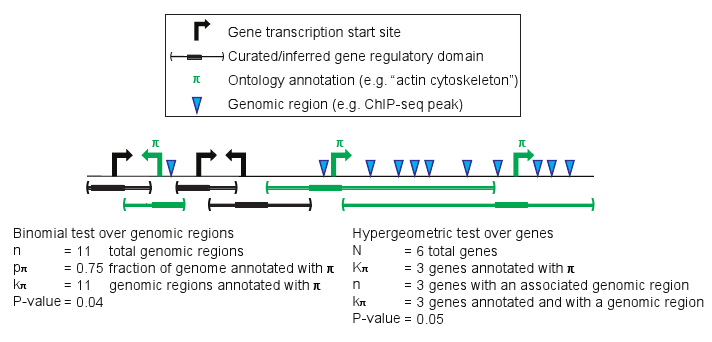
When GREAT runs against a whole genome background, it calculates two measures of enrichment: one using a binomial test over genomic regions and one using a hypergeometric test over genes. When GREAT runs against an explicit background set of genomic regions, it calculates a single enrichment value using a foreground/background hypergeometric test over genomic regions.
GREAT performs both the binomial test over genomic regions and the hypergeometric test over genes to provide an accurate picture of annotation enrichments for genomic regions. Each test has a bias that is compensated by the other test.
The binomial test is a statistical test calculated for a set of genomic regions. In this test, every annotation is ascribed a probability that a randomly placed genomic region is assigned the annotation. This probability is the fraction of the genome over which a genomic region is associated to a gene with the annotation. Thus, it accounts for the varying sizes of the regulatory domains of genes. Formally:
The binomial p-value equals the probability of having k? or more of the n test genomic regions in the regulatory domain of a gene with annotation ? given that the probability of that occurring for a single genomic region is p?.
Binomial P-value = 
The hypergeometric test is the standard gene enrichment test applied by tools such as DAVID. It is a statistical test calculated for a set of genes. In this test, a gene is included in the test set if a test genomic region is associated with the gene. The hypergeometric test specifies whether this test gene set is enriched for any annotations out of the full set of genes in the genome. It is applied independently for every annotation ?. Formally:
The hypergeometric p-value equals the probability of choosing k? or more genes with annotation ? when randomly drawing n genes from the genome.
Hypergeometric P-value = 

If you provide an explicit background set, GREAT uses a different statistical test than for a whole genome background, a foreground/background hypergeometric test over genomic regions. Unlike the similarly-named hypergeometric test over genes used with a whole genome background, it is not biased by the differing sizes of the regulatory domains of genes.
The foreground/background hypergeometric test is a statistical test calculated for a set of genomic regions. It specifies whether a foreground (test) set of genomic regions is enriched for any annotations out of the full set of background genomic regions. The foreground genomic regions are specified in the test set, and the background genomic regions are specified in the background set. All foreground regions must be present in the background set. Formally:
The hypergeometric statistic equals the probability of choosing k? or more genomic regions with annotation ? when randomly drawing n genomic regions from the background set.
Hypergeometric P-value = 
GREAT calculates numerous statistics to guide the framing of novel hypotheses about the test set. Different statistics offer different perspectives on the data, allowing different types of potential hypotheses to be examined.
By default, GREAT ranks results by the binomial p-value, and we consider this the single best way to examine genome-wide cis-regulatory datasets. It accounts for biases in gene regulatory domain size and provides an accurate picture of the cis-regulatory landscape. Still, it is important to examine other statistics too:
When testing a family of hypotheses simultaneously, the likelihood of incorrectly rejecting the null hypothesis for at least one member of the family increases. To correct for this, a multiple hypothesis test correction is often applied.
GREAT offers two multiple hypothesis test corrections for testing m hypotheses at a significance threshold of ?:
The Bonferroni correction is a conservative multiple hypothesis test correction. It requires a raw p-value of ?/m for significance.
The Bonferroni corrected p-value displayed by GREAT equals (m * raw p-value).
The false discovery rate correction enables control of the expected number of incorrect rejections of the null hypothesis. To perform the FDR correction, the hypotheses are ranked in decreasing order of p-value (from 1...k...m). Then the largest k is found such that the kth p-value < k?/m. The first k terms are considered significant.
The FDR q-value displayed by GREAT equals (m * raw p-value / k). Note that the q-values are not necessarily monotonically increasing (the q-value for the (k+1)th best raw p-value can be smaller than the q-value for the kth best raw p-value due to the division by rank k). Consequently, a q-value above the significance threshold can be significant if a later q-value satisfies the significance criteria (e.g. if the q-value for the 5th best raw p-value is 0.06 but the q-value for the 10th best raw p-value is 0.04, then all of the top ten terms are significant at a 0.05 level).
An important factor in multiple hypothesis test correction is the number of hypotheses tested, m. In practice, however, many of the annotation terms ("hypotheses") are applied to very few genes in the genome and have little chance of satisfying significance thresholds (even if your set tags every one of the genes with the annotation). These "extra" annotation terms place a higher burden on the other hypotheses in multiple hypothesis test correction.
The minimum (maximum) term annotation count is the smallest (largest) number of genes in the genome to which an annotation must be applied for consideration. So, if you set the minimum term annotation count to 5, then only annotations that are applied to at least five genes in the genome will be tested. This decreases the number of hypotheses tested and provides a fairer m for multiple hypothesis test correction of the other hypotheses.
Since GREAT's results are obtained using floating point arithmetic it has limitations imposed on the amount of precision it can output. Occasionally, the output p-values will be 0 since the lowest pvalue that GREAT can return is 1E-324. Enrichments more significant than this will show a pvalue of 0.